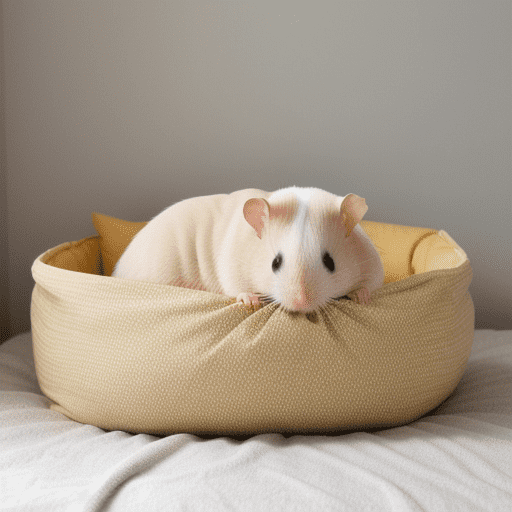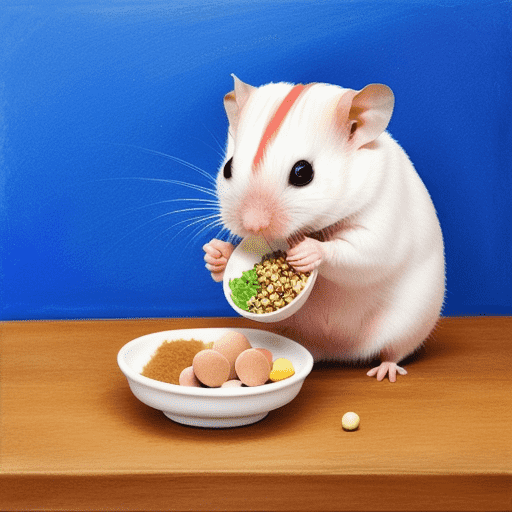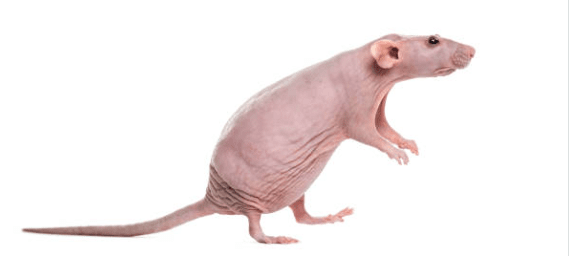Piqued your interest in the fascinating universe of hairless hamsters, did you? It’s no wonder.
As a seasoned pet expert and connoisseur of all things furry (or, in this case, furless), I find hairless hamsters utterly captivating.
These fascinating creatures, unique and delicate, demand specialized care. Nurturing a hairless hamster presents a different kind of challenge, full of rewarding moments.
With proper guidance, you can provide a secure and comfortable habitat for your hairless companion.
Stepping into the realm of hairless hamster care, you’ll soon discover it’s a journey of learning and adaptability.
This guide will help light your path, giving you the knowledge you need to raise a happy and healthy hairless hamster.
Table of Contents
Characteristics and Appearance of Hairless Hamsters
Hairless hamsters are a breed apart. They possess the same adorable features as regular hamsters, albeit sans fur. These bald beauties typically have the following:
- A soft, warm skin devoid of fur
- Pink or peach-colored tones
- Wrinkles which increase with age
The hairless gene, a quirk of nature, results in hamsters that are smooth to the touch. Despite their name, hairless hamsters may have patches of fur, particularly around the nose or feet. This might seem peculiar, but it only adds to their distinctive charm.
Different Breeds and Variations of Hairless Hamsters
Hairless hamsters come in a delightful array of breeds and variations. Each has unique traits and demands distinct care. Below, we’ll explore these breeds more closely.
Sphynx Hamster
Sphynx Hamsters, unique and captivating, are often the first hairless breed that comes to mind. Resembling their cat counterparts, they have wrinkled skin and expressive eyes.
Hairless Syrian Hamster
Next, we have the Hairless Syrian Hamsters. Also known as Teddy Bear Hamsters, they’re renowned for their gentle nature. Hairless Syrians, devoid of their trademark fluffy coat, present an adorable sight with their bare, peachy skin.
Hairless Roborovski Hamster
The Hairless Roborovski Hamster, the tiniest of the lot, is an energetic little creature. Hairless or not, they are known for their lightning-fast speed and nocturnal habits.
Hairless Campbell’s Dwarf Hamster
The Hairless Campbell’s Dwarf Hamster, affectionately known as the “Bald Campbell,” is a charming and sociable breed. Despite being hairless, their endearing features make them a beloved pet choice.
Hairless Russian Dwarf Hamster
Finally, we have the Hairless Russian Dwarf Hamsters. Small but mighty, these hamsters are friendly and relatively easy to care for, making them a perfect choice for beginners.
Creating a Suitable Environment
Creating a comfortable and secure environment for your hairless hamster is the cornerstone of ensuring their health and happiness.
Providing a Warm and Draft-Free Habitat
Unlike their furry counterparts, hairless hamsters lack the natural insulation of fur. Consequently, a warm and draft-free habitat is paramount. Your hamster’s enclosure should be placed in a well-insulated area, away from windows, doors, and air vents to avoid drafts.
Selecting Appropriate Bedding and Nesting Materials

Soft, comfortable bedding is crucial for hairless hamsters. Opt for hypoallergenic, dust-free materials like paper-based or aspen shavings, and avoid cedar or pine bedding which can cause skin irritation.
Additionally, providing nesting material like unscented tissue paper can help them feel more at home.
Ensuring Proper Humidity Levels for Hairless Hamsters
Maintaining the correct humidity level is another critical factor in your hairless hamster’s habitat. An environment that is too dry can irritate their skin, while excessive humidity can lead to respiratory issues.
Investing in a hygrometer to monitor humidity can be beneficial in maintaining a balanced habitat for your pet.
Nutrition and Diet
Just like their furry counterparts, hairless hamsters need a balanced and nutritious diet. However, there are a few unique considerations to bear in mind.
Unique Dietary Considerations for Hairless Hamsters
Due to their lack of fur, hairless hamsters burn more calories to maintain body heat. Therefore, they may require a higher caloric intake compared to their furry counterparts, necessitating certain adjustments to their diet.
Appropriate Food and Supplements

A balanced diet for a hairless hamster includes commercial hamster food, fresh fruits, vegetables, and, occasionally, small servings of protein. Supplements can also be beneficial to provide that extra calorie boost and fill any nutritional gaps in their diet.
Hydration and Water Requirements
Proper hydration is vital for hairless hamsters. Their lack of fur can lead to a higher risk of dehydration, particularly in warmer conditions. Therefore, ensuring they have a constant supply of fresh, clean water in their cage is non-negotiable.
Staying hydrated helps them stay healthy, active, and happy.
Grooming and Skin Care
Hairless hamsters possess a unique charm that’s hard to resist. However, beneath that adorable exterior, they require specific care to maintain their skin’s health and comfort.
Special Grooming Needs for Hairless Hamsters
Hairless hamsters, with their sensitive, fur-free skin, necessitate a gentle grooming regimen. Regular cleaning is key, but beware – over-bathing can strip the natural oils from their skin, leading to dryness and irritation.
Skin Health and Preventing Dryness
Maintaining skin moisture is critical in hairless hamsters. Dryness can cause discomfort and health issues. Keep an eye out for signs of dry skin, and don’t hesitate to use a gentle, pet-safe moisturizer to help keep their skin soft and healthy.
Protecting the Sensitive Skin from Sunburn and Irritants
Just like us, hairless hamsters are susceptible to sunburn and skin irritations. Keep their habitat away from direct sunlight, and steer clear of irritants such as strong cleaning products.
Also, ensure their bedding material is comfortable and non-irritating to their delicate skin. After all, a comfortable hamster is a happy hamster.
Common Health Issues in Hairless Hamsters
Hairless hamsters, while charming, are prone to specific health issues. Awareness and early detection are key to maintaining their health.
Skin Sensitivity
Hairless hamsters have sensitive skin that can be prone to cuts, scratches, and dryness. Regular check-ups and appropriate skin care can help mitigate these issues.
Temperature Regulation
Without fur, hairless hamsters have trouble regulating their body temperature. Ensure their habitat is warm and comfortable, especially during colder months.
Sunburn
Exposure to direct sunlight can lead to sunburn in hairless hamsters. It’s best to keep their habitat away from sunlight and use UV-protected cages if possible.
Eye Problems
Some hairless hamsters may experience eye problems, possibly due to their genetic makeup. Regular vet visits can help catch any potential issues early.
Respiratory Issues
Hairless hamsters may experience respiratory issues, especially in a habitat with improper humidity levels. Maintaining a balanced environment is crucial.
Dental Problems
Like all hamsters, hairless breeds are prone to dental problems. Providing chew toys and a diet with ample roughage can help promote dental health.
Proper Handling Techniques for Hairless Hamsters
Every part of hairless hamster care, including handling, needs a gentle touch. Some points to remember are:
- Always wash your hands before handling your hamster to avoid transmitting germs or irritants.
- Approach your hamster slowly and gently to prevent startling them.
- Lift them carefully, supporting their whole body.
- Limit handling time to prevent them from getting too cold.
Conclusion
Navigating the unique world of hairless hamsters requires patience, care, and understanding. Despite their specific needs, these endearing pets can bring immeasurable joy and companionship.
Remember, a well-informed pet parent is a successful one. By understanding your hairless hamster’s needs, providing appropriate care, and staying vigilant about their health, you can ensure a happy and fulfilling life for your furry (or furless) friend.
FAQs
Are hairless hamsters good pets?
Yes, hairless hamsters can make wonderful pets, provided you’re prepared to give them the extra care and attention they require due to their lack of fur.
How long do hairless hamsters live?
Hairless hamsters typically have a lifespan of 2-3 years, similar to their furry counterparts, although this can be influenced by factors such as genetics, diet, and quality of care.
Can hairless hamsters get cold?
Yes, hairless hamsters can easily get cold due to their lack of fur, so it’s essential to provide a warm habitat, especially during colder months.
Alina Hartley is a small-town girl with a ginormous love of bearded dragons. It all started with Winchester, a baby bearded who was abandoned at the shelter by his former owners because of a birth defect that caused one front leg to be shorter than the other. Alina originally went to the shelter looking for a guinea pig, but one look at Winchester and it was love at first sight. From that day on, Alina has dedicated her life to learning everything she can about bearded dragons. She loves helping new beardie parents start their incredible journey with these magnificent reptiles.
Follow her on:
LINKEDIN
TWITTER.
Read her latest articles HERE
Learn more about her HERE.

